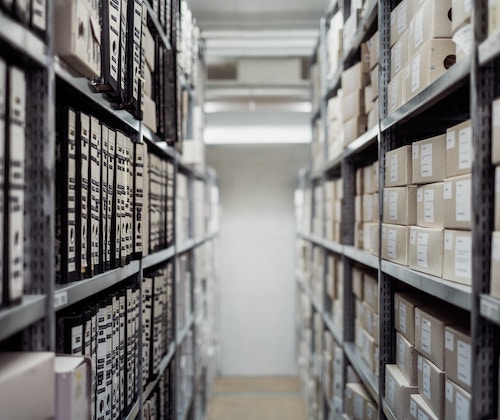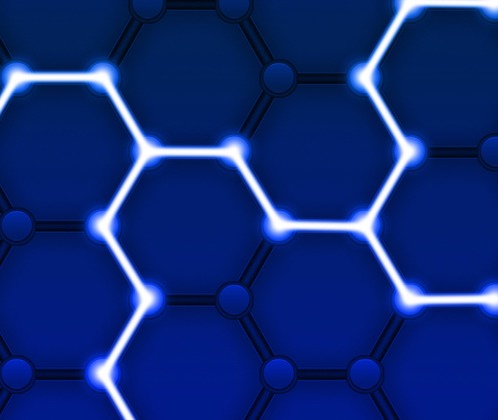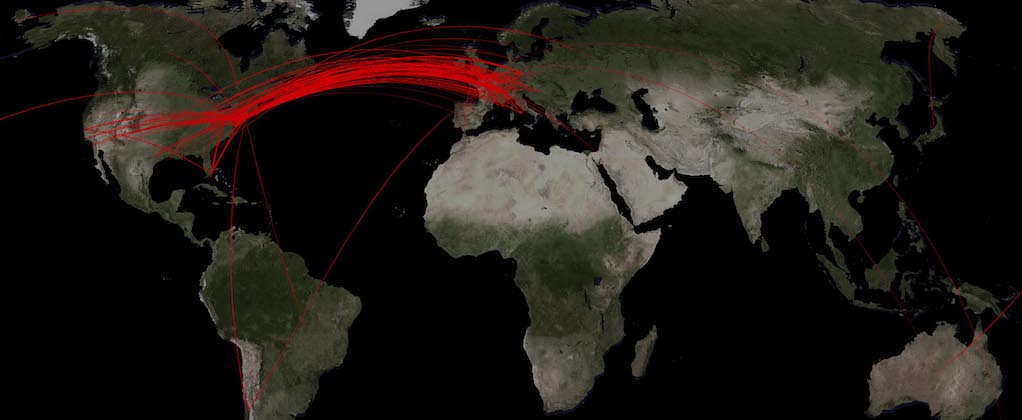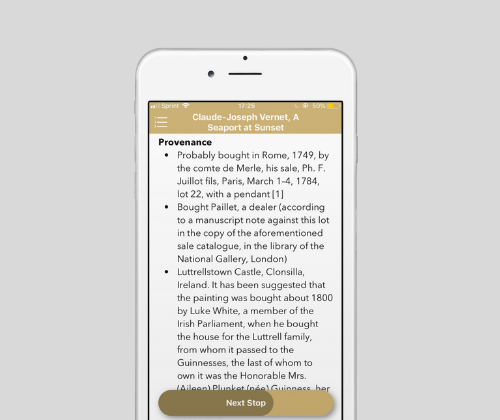Provenance, or art’s history of ownership, is a growing area of discussion for museums across the world. As the Philadelphia Museum of Art so eloquently describes, “the provenance of an individual work of art sheds light on its historical, social, and economic context as well as its critical fortunes through time.”
Provenance is essential for establishing the legitimacy, value of a work of art, as well as a core ethical consideration for museums. For example, provenance issues are notoriously difficult for the period between 1933 and 1945 in Europe, the time of Nazi rule. Through practices of looting and coercion, Nazis unjustly “acquired” art and cultural artifacts on a massive scale from the territories they conquered. The National Archives estimates that some 20 percent of the art of Europe changed hands during Nazi rule. The issue of Nazi-era provenance is of such great magnitude that the American Alliance of Museums has separate standards and best-practice statements regarding museums’ obligations in this area.
Colonial provenance is yet another ethical matter that museums have to contend with. Many objects in collections across Western countries were acquired during the colonial period. There is an ongoing debate in the Netherlands regarding repatriation of artefacts acquired during the colonial era. Just a few months ago, Germany allocated over $2 million in funding for colonial era provenance research. And this year, Britain’s leading museums are also employing full-time staff to revisit their colonial-era collections.
In addition to these ethical concerns, provenance also involves questions of authentication and education. It is estimated that 15-20% of art in museums and on the market is either forged or misattributed. For museums to be cultural stewards and premiere educators, they need more accurate provenance information.
All this means that researching provenance, and educating visitors about provenance, is a key responsibility for museums. It’s included in the AAM guidelines that “museums should identify covered objects in their collections and make public currently available object and provenance information.” But this can be a hefty task.
That’s where technology can come in handy. A range of technological tools are opening new doors for provenance research and education. These have the potential to change how museums collect and distribute provenance information.
Here are 4 technology trends that can transform the future of provenance research and education:
Increasing Access to Digital Archives and Data Sets
Creating a digital archive of museum objects and including information about provenance can be a great way to promote provenance research and transparency. The Getty Research Institute, for example, is engaged in a special Project for the Study of Collecting and Provenance. The heart of this research project is the Getty Provenance Index databases, which “contain more than 1.7 million records taken from source material such as archival inventories, auction catalogs, and dealer stock books.”
Another large scale digital database project is the German/American Provenance Research Exchange Program, a transatlantic initiative that has produced an object database focusing on provenance in the World War II Era. The Nazi Era Provenance Research Portal is another central registry for U.S. museums to publicize provenance information.
These archives are one step forward towards collecting data about art in a format that is clean, accessible, and easy to analyze. Neal Stimler, Senior Advisor at the Balboa Park Online Collaborative, has championed museums’ transition towards detailed, open-access data sets. According to Stimler,
[museums] need to build tools to provide mass self-serve access to data and digital assets sets. These tools typically come in the form of a museum's collection online website, a public application programming interface (API), and a GitHub repository of data in the .CSV and .JSON formats.
These data sets include rich, interesting details, including provenance history!
Leveraging Artificial Intelligence
What do you do when you encounter works of art that have a dubious history of ownership, or when their authenticity is in question? Even if provenance information exists somewhere, it can be far-flung and racked with discrepancies, with bits and pieces scattered across distant archives and auction ledgers.
How could advancements in technology like AI play a role in determining the origins of these types of works, and solve the problem of decentralized information and limited expert resources to dig through these archives?
AI has the ability to mine through and analyze public and private records, archives, and other data sources, which can flag or uncover things that could not easily be discerned by a human.
But perhaps provenance research comes up dry, making it difficult to attribute a work properly. What’s more, historically, dynasties or circles of artists practiced very similar styles – for example, the famous Bruehgel was heavily influenced by his father, Pieter Bruegel the Elder. With artists constantly replicating each other’s work and emulating styles, attribution can become an impossible task.
AI can also be a helpful tool here: AI can pick up many more details with greater ease and precision than the best-trained human eye, and it can be harnessed to attribute artwork properly. This makes it possible to identify the true origins of works of art.
AI can also be used to identify forgeries. With 15-20% of art in museums and on the market either forged or misattributed, that leaves room for a lot of unanswered questions and controversies. For example, in 2018 two art historians entered into a vicious dispute during an art-forgery trial, one arguing that the suspect Malevich paintings were authentic, the other equally convinced that they were forged.
Art historians currently rely on a range of tests to determine if art has been forged, such as infrared spectroscopy, radiometric dating, and gas chromatography. But AI doesn’t require any of these tests – it can spot a fake just by analyzing the strokes used to create a piece. As featured in MIT Technology Review, “researchers from Rutgers University and the Atelier for Restoration & Research of Paintings in the Netherlands document how their system broke down almost 300 line drawings by Picasso, Matisse, Modigliani, and other famous artists into 80,000 individual strokes.” And just this year, researchers in Massachusetts have trained a neural network to spot the difference between real oil paintings by 17th century Dutch painter Rembrandt and clever imitations.
Basically, AI is a game changer when it comes to establishing an accurate attribution and provenance of artworks.
Linking up to Blockchain
Most people immediately associate “blockchain” with Bitcoin, but cryptocurrency is only one application of this technology. In simple terms, a blockchain is a chain of blocks that contain information. How does it work? According to Culture Track:
The information each block contains must sequence accurately with preceding and subsequent blocks in the chain; as such, it is almost impossible to change the information in a block once it has been recorded. At its core, blockchain offers a new way of tracking information across a decentralized network of devices, making data publicly-verifiable and increasing its security.
While this may sound complicated and far-off, blockchain already has tried-and-true applications in art provenance. Using blockchain, an accumulation of data could populate a digital ledger that tracks the provenance of all works of art. Because blockchain is so secure, it would be nearly impossible to alter this data. This would help tackle the problem of incomplete or inaccurate provenance information. This means that museums could be certain of provenance of every acquisition and solve the problem of dispersed, inaccurate, or forged records.
A number of forward thinking startups working on the intersection of art and technology have already begun utilizing blockchain in this way. For example, Verisart is “a blockchain platform that helps users create secure digital certificates for art and collectibles.” Artory is another startup which “tracks provenance for art and other collectibles using a blockchain ledger to make sure that custody chains are authentic and tamper-proof.” And those are just a few examples of a slew of startups using blockchain in this way.
Keep note, however: blockchain isn’t a magic bullet for bad data. To make the most of blockchain technology, it’s important to ensure that the information going onto the digital provenance ledger is accurate to begin with.
Highlighting Provenance Information with Digital Technology
Data sets, artificial intelligence, and blockchain are all useful ways of collecting and managing provenance information, but how can this be communicated to the public as they stand before the work of art? Lots of general visitors won’t specifically seek out a digital archive, read the “fine print” on museum wall plaques, nor is there room to fit all of that information. So, how do you make this information accessible?
One innovative leader in digitally-driven provenance education is Carnegie Museum of Art with their Art Tracks initiative. Art tracks “aims to turn provenance into structured data by building a suite of open source software tools.”
Credit: ArtTracks
Using innovative interactive data visualization solutions, the Art Tracks project is at the forefront of the movement to make provenance accessible to wider audiences.
Another great way to educate audiences on provenance is to incorporate provenance information into a mobile tour app for your museum. In 2017, our partner, the Davis Museum, created a dedicated in-app tour as part of their Art-less initiative, which either de-installed or shrouded all works in the galleries that were created or given by immigrants. This tour highlights the diverse origins and history of ownership of many objects in the collections, and the critical role that immigrants play in the arts. The app tour spotlights specific objects that were part of Art-Less.
Another one of our partners, the Timken Museum, includes detailed and accessible provenance information for each work of art highlighted along their mobile-app tour. This is an easy way to spark visitor curiosity and in complex issues of how art changes hands.
Mobile app tours can be an exciting way to feature provenance information and help make provenance a part of the educational experience at museums.
With the increasing focus on provenance and related ethics, new tools are constantly available to aid in research and education. By taking note of these latest trends, museums will be able to deepen their efforts in collections stewardship and maintaining standards of excellence.
Further Reading:
This AI Can Spot Art Forgeries by Looking at One Brushstroke
Should we relinquish our insistence on privileging original works of art?
Carnegie Museum of Art Makes its Provenance Accessible and Interactive
Better Safe Than Sorry: American Museums Take Measures Mindful of Repatriation of African Art







